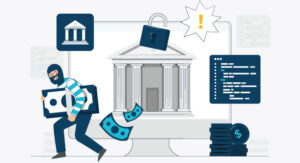How to Avoid Bank Frauds Using Technology?

Want to know how to avoid bank fraud? Well, the first step is to follow the basic old-school step with a blend of technology. Fraud is a worldwide phenomenon that affects all multiple industries and can even have a severe impact on the economy of a country. Banks need to understand how to prevent bank frauds, which they can’t do without employing the right kind of technology. One of the most challenging aspects of the banking sector is to make sure that all online transactions are free from any kind of electronic fraud. Technological advancement and adoption is the only answer to the question of “how to control fraud in banks”.
By utilizing the power of data analytics, banks can detect fraud in their initial step and reduce the negative impacts of significant losses regarding fraud. This is one of the primary methods how to prevent bank fraud.
The present-day studies indicate that false documentation and inadequate training of employees are the reason for 60% of all banking fraud cases. Most of the frauds in banking institutions are detected through customer complaints or some external tip, which is the case with global banking frauds. To mitigate risks, banks need to learn how to prevent online banking fraud.
Large and small businesses alike are targets of online bank frauds, it is also called ACH fraud or wire fraud. Once cybercriminals can find a weak point in the banking system, they can create a lot of nuisance before being detected finally.
Banks, financial institutions, and FinTechs need to understand the need for technology so they can reduce the number of frauds they have to suffer through. If you wish to understand how to prevent online banking fraud, then you need to employ technologies such as DIRO’s document verification technology.
Technologies For Online Banking Fraud Prevention
1. Multi-Factor Authentication
The best step is to start with a multi-factor authentication structure to improve the first layer of security. Financial institutions can’t solve all their problems just by using multi-layer authentication, they need to start from somewhere. One of the major mistakes made by financial institutions is to leave everything on a single solution which makes them more open to being compromised.
If financial institutions can set up a solution like combining old-fashioned phone calls for bank authentication with online two-factor authentication, they can reduce the risk of fraud by a lot. In the old days of banking, calendars were put in place for all transactions across multiple accounts. If someone has the same banking and transaction routine, then any sudden changes would be marked as red flags.
2. Banks Need to Monitor Transactions
In the earlier days of banking, banks used to have daily limits imposed on their users. The banks used to impose the limit on their mainframe processor, along with file limits and batch limits, this limit would help to spot if there was something out of the ordinary. Usually, banks don’t watch out for any activity under $9,000 which makes it easier for criminals to fraud the banks by conducting activities under $9,000. One of the best ways how to prevent bank fraud is to monitor transactions more carefully.
3. Employ Dual & Triple Controls
Dual controls on the corporate side are the minimum they can do to reduce the risk of online fraud. The ideal suggestion is to use triple controls, where one person initiates the transaction, a second person approves the transaction and the third person finishes it.
If organizations don’t have the right kind of resources or people to follow up with the triple controls, then they need to set up ACH transactions. Businesses can confirm using a phone call if the transaction was initiated by a specific person, once that is confirmed, the transaction can be completed. This can be done using a person or by setting up an IVR. Usually, only one person will have the ID and password to call the bank and complete the transaction which adds an extra layer of security.
4. Raise Awareness Towards Fraud
One of the best ways how to control fraud in banks is to keep educating the customers about the ways they can reduce fraud. The rise of online banking has given rise to a lot of online fraud. Banks and other financial institutions can employ all the technology they want but the real solution won’t happen till customers are aware of the threats.
5. DIRO Document Verification Technology
This is one hardcore technological solution to make sure banks, financial institutions, and FinTechs can mitigate the risk of online fraud. Using the technology, organizations can streamline the customer onboarding process and verify documents to reduce online fraud and money laundering.
DIRO’s document verification technology can verify documents like bank statements, bank account verification, utility bills, address proof, and student records. During the customer onboarding process, banks can verify customer documents to make sure the customers are who they say they are. Money laundering and terrorist funding can be stopped by verifying customers before they can cause any real problems.













